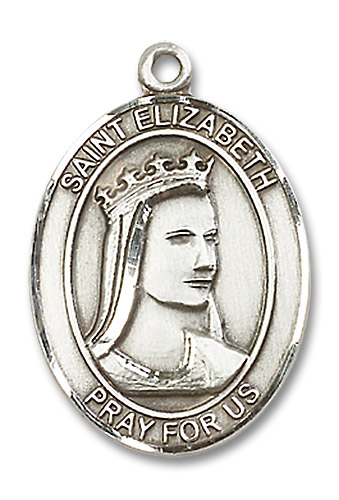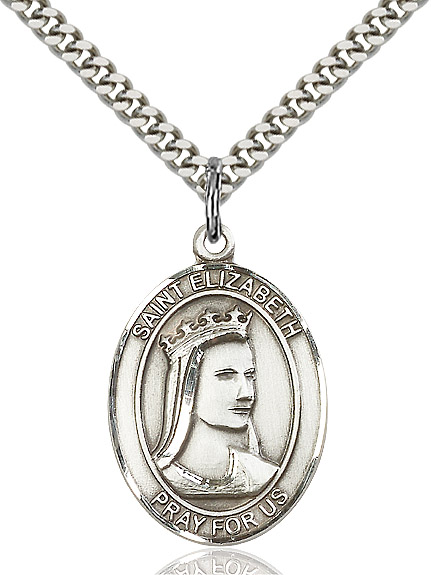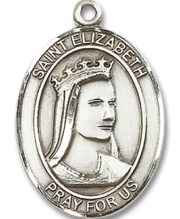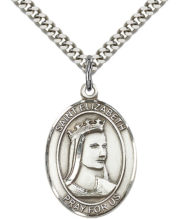$58.99 – $1,254.00
St. Elizabeth Of Hungary Medal
- St. Elizabeth of Hungary is the patron saint of bakers, beggars, and nursing services.
- St. Elizabeth of Hungary’s feast day is celebrated on November 17th.
This St. Elizabeth Of Hungary medal has been proudly hand-made for over a century by Bliss’ team of artists in Rhode Island. The St. Elizabeth Of Hungary medal is crafted to last a lifetime.
St. Elizabeth Of Hungary Medal
This St. Elizabeth Of Hungary Medal and Necklace features a pendant with a hand pressed image of St. Elizabeth of Hungary surrounded by the words ‘St. Elizabeth Of Hungary Pray for Us’.
Sterling Silver St. Elizabeth Of Hungary Medal and Necklace
14KT Gold Filled St. Elizabeth Of Hungary Medal and Necklace
14KT Gold St Elizabeth Of Hungary Medal
St. Elizabeth of Hungary
Elizabeth, daughter of Andrew II, King of Hungary, was born in 1207. When only four years old she was sent to the Court of Hermann, Landgrave of Thuringia, to be betrothed to his son, Ludwig. She was brought up at the Thuringian Court, in accordance with the customs of those times, and educated in company with her future husband, so that from their childhood they loved each other as most dear companions.
A Great Love for God
From her earliest years Elizabeth possessed, by the grace of God, a marvelous spirit of prayer, great simplicity and profound charity. She hated rich garments, and avoided taking part in the pomp and ceremonies of the Court. Her great joy was to visit the poor and the sorrowful, to minister to their needs, to relieve their sufferings. In the meantime she had to contend with future relatives who had little, if any, sympathy with her life filled with works of charity.
Elizabeth and Ludwig were married in 1220. Hardly more than a child in years, Elizabeth entered upon the full duties and responsibilities of womanhood. Thanks to the influence of her example and that of her husband, the Thuringian Court became famous throughout Germany for the valor and honor of its knights and the purity and holiness of its ladies. But it was not by her individual good works alone that Elizabeth came to be known and loved throughout the whole extent of her husband’s dominion and beyond it.
As a couple, they were untiring in their efforts to help the weak and the oppressed. To Ludwig is due the foundation of the famous Benedictine Abbey of Reinhardsbrunn, while Elizabeth rejoiced to welcome the first Franciscan Friars to Eisenach, and placed herself under their direction. With her husband’s permission, she multiplied her works of mercy, for her love of the poor was boundless.
Miracle of Roses
Even in her dress she endeavored to be like them. One day as she was carrying under her mantle some provisions for the poor, she met her husband returning from the chase. “What have you there, sweet lady” asked Ludwig, Elizabeth opened her cloak, and behold! the heavy burden was no longer there-only some beautiful fragrant roses, although it was not the season for them. The roses that grow on the steep hillside above Eisenach are still called “Elizabeth Blumen”, “Elizabeth’s flowers”
Eight years had passed since their marriage. These were years of extreme happiness and increased saintliness. Elizabeth had become the mother of one son and two daughters and was expecting another child; but the time of trial was at hand. While on his way with a new Crusade to the Holy Land, with the Emperor Frederick Barbarossa, Ludwig fell a victim to fever which broke out amongst the imperial troops before they embarked from Brindisi. He died at Otranto, with the calm resignation of the true Christian knight he had always been.
Elizabeth, with her children, was stripped of everything by her brother-in-law, who was bent on usurping the inheritance which rightly belonged to Elizabeth’s son, Hermann. Elizabeth was driven from her palace and after wandering through the streets with her little children, a prey to hunger and cold, was finally befriended. She welcomed all her sufferings. She gave her little son Hermann to be educated as a worthy son of his father, and in due time to enter upon his inheritance. Her eldest daughter was betrothed, as she had been, to the Duke of Hesse-Cassel, and confided to the care of her future husband’s mother. The two youngest she placed in the care of her aunt the Abbess.
Giving Her Final Years to God
Then on Good Friday, 1230, Elizabeth made the supreme sacrifice. Kneeling before the Crucifix, she laid aside her widow’s sombre robes and assumed the coarse brown Habit of St. Francis, dedicating herself finally to serve God in absolute poverty and humility. She busied herself to the day of her death in works of charity and piety. In 1232, God revealed to her the time of her death, which came just before dawn on November 19, 1232. Her relics are enshrined at Marburg, the place of her decease, in Thuringia. Four years after her death she was canonized by Pope Gregory IX.
St. Elizabeth of Hungary Rosary
UPC: 617759601596
Brand: Bliss
| Metal Finishing | |
|---|---|
| Size |
Be the first to review “St. Elizabeth Of Hungary Medal and Necklace” Cancel reply
You must be logged in to post a review.





Reviews
There are no reviews yet.